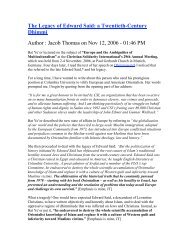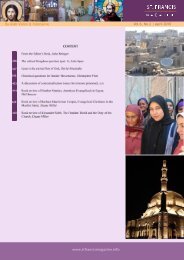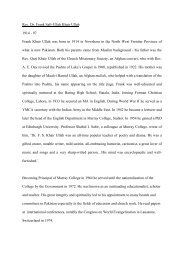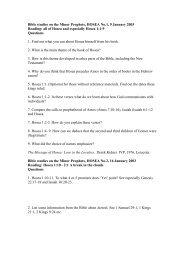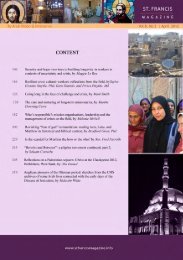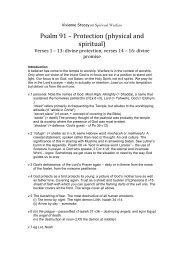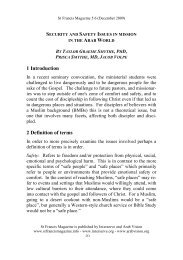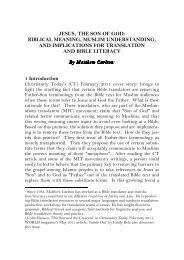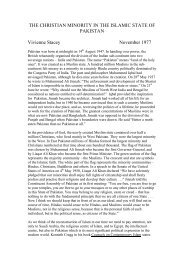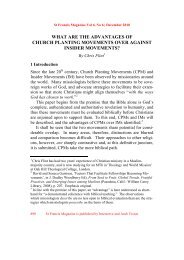download the pdf - St.Francis Magazine
download the pdf - St.Francis Magazine
download the pdf - St.Francis Magazine
You also want an ePaper? Increase the reach of your titles
YUMPU automatically turns print PDFs into web optimized ePapers that Google loves.
<strong>St</strong> <strong>Francis</strong> <strong>Magazine</strong> Vol 8, No 4 | August 2012<br />
ist cultures, where “I” is less clearly distinguished from “we” than in<br />
<strong>the</strong> West.<br />
2.3. Making <strong>the</strong> model more sophisticated<br />
In outlining this three-layer model I again stress that it is only a<br />
very simple starting point. Each layer is merely <strong>the</strong> setting for a<br />
great deal of fur<strong>the</strong>r sub-division, movement and complexity. We<br />
might elaborate <strong>the</strong> model to make <strong>the</strong> “core identity” level a stage<br />
whereon different worldviews raise <strong>the</strong>ir voices like actors, each<br />
clamouring to be heard and obeyed. 71 At <strong>the</strong> “social identity” layer<br />
we might draw a series of circles, some overlapping and some rigidly<br />
separate, to illustrate an individual’s multiple identities and/or roles.<br />
We might change <strong>the</strong> “collective identity” layer into a composite set<br />
of layers bonded toge<strong>the</strong>r like plywood, with <strong>the</strong> different layers labeled<br />
“ethnic”, “national”, “religious”, “socio-economic” and so on.<br />
Elaborating fur<strong>the</strong>r still, we might change our three layers into a<br />
three-floor department store, with each floor having inter-connecting<br />
and rearrangeable departments, and with escalators to move ideas<br />
continually up and down between <strong>the</strong> “core” and “social” floors.<br />
Buildings, however, don’t move. People move and develop and<br />
change throughout life. They leave home, marry, change roles, juggle<br />
multiple identities and bring up children in a different environment<br />
from <strong>the</strong> one in which <strong>the</strong>y grew up. Identity change takes<br />
place with ever-growing speed in a world where migration and hybrid<br />
identities are more and more common.<br />
Therefore no model can adequately depict identity in all its complexity<br />
of identity. Even so, models have <strong>the</strong>ir place. So long as we<br />
recognize its limitations, our tripartite conceptualization of identity<br />
will still carry us quite a long way in understanding what it is to be<br />
Muslim and what it is to convert.<br />
71 See Jens Barnett’s chapter in <strong>the</strong> forthcoming book Longing for Community (ed.<br />
David Greenlee). I have enjoyed learning from Jens as we interacted on models of<br />
identity.<br />
<strong>St</strong> <strong>Francis</strong> <strong>Magazine</strong> is a publication of Interserve and Arab Vision 526




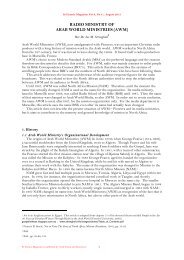
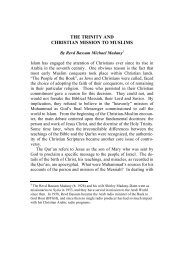
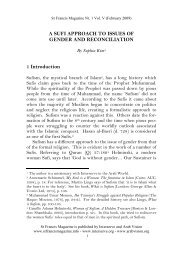
![Reflections on Surah Fatiha and the Lord's Prayer[1] - St.Francis ...](https://img.yumpu.com/49377951/1/184x260/reflections-on-surah-fatiha-and-the-lords-prayer1-stfrancis-.jpg?quality=85)
